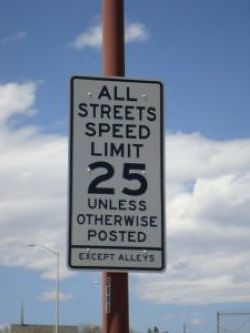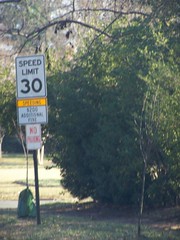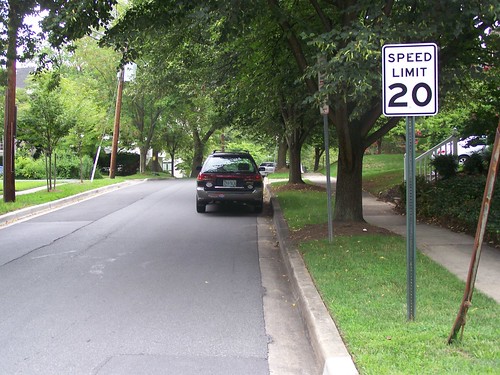Traffic safety and stage 4 of Moral Development Theory
Yesterday's Post has a story "As tensions rise among D.C. road users, many say police enforcement lags," which addresses perceptions of inadequate traffic safety enforcement in DC. The story headline in the actual printed paper was "Walkers, bikers, drivers agree: Rules are rules."
(For a different and more rounded take see "Bicycles and cars: can they share the road? Cities balance popularity of bicycling with need for safety" from the South Bend Tribune.
Photo from the South Bend Tribune article "Trail signs: Walk, bike nicely 'Etiquette' urged to ease conflicts among users."
The signs were created by the Bike Michiana Coalition for use on trails in South Bend, Indiana. (Bike trails in DC tend to lack this kind of signage.)
I don't agree with the headline at all.
In the context of street safety, pedestrians and cyclists are the most vulnerable users. But the way the highway safety regime works (see "Wrong Turn: How the fight to make America's highways safer went off course by Malcolm Gladwell from the New Yorker), drivers are expected to be negligent, to even kill people, and the system isn't intended to hold them responsible for such transgressions, but to expect and coddle such behavior.
This makes no sense, considering that motor vehicles, because of their weight and speed, are far more dangerous to vulnerable users compared to the minimal if nonexistent danger that vulnerable users pose to motor vehicles.
The mobility regime should prioritize protection for the most vulnerable user.
Pedestrians > Bicyclists > Motor Vehicles
That's how it's done in the Netherlands, although it took a few decades for this to occur, years after the country began focusing on rearticulating transportation policy around sustainable mobility.
It's not just about "rules" because the system of traffic regulation has been created to favor motor vehicle operators and to downplay the responsibility of motor vehicle operators for "accidents."
Plus, the rules are designed to cripple the efficiency of bicycling by requiring stopping at all stop signs and traffic signals even when there is no oncoming traffic.
It makes no sense to follow the rules when the rules are flawed.
The focus should be on fixing the rules and the mobility environment so that people don't break the rules in the first place.
Plus, if the broader system supported people performing the right behavior as opposed to breaking the rules, we wouldn't need to expect the police, who have extremely limited resources, to spend most of their time doing traffic safety enforcement.
Moral development theory and following the rules. Lawrence Kohlberg was a professor at Harvard University who researched and wrote extensively about moral development theory. He theorized three levels: pre-conventional; conventional; and post-conventional, with two stages in each level. Conventional morality is where the majority of the population is at, while post-conventional reasoning is based on the idea of a "social contract" and connectedness with others.
The fourth stage is titled "law and order" and is focused on following the rules--regardless of whether or not the rules are broken or flawed.
People at higher levels of moral reasoning are capable of questioning rules, especially when the rules as created are flawed and/or problematic.
Traffic enforcement and criminal justice. This is a topic deserving of more space than I want to write about at the moment. There needs to be more enforcement with regard to reckless actions that endanger others. That is true for all modes--pedestrians who walk out into the middle of the street when the light is green, cyclists who ride against traffic or run red lights and stop signs in the face of oncoming traffic, and drivers who speed, kill, and maim. As well as inadequate training of police officers as "accident investigators" and their bias in favor of motor vehicle operators.
Plus, the issue of how the criminal justice system is designed to excuse negligent behavior--even if it results in death--by motor vehicle operators unless it is the result of being impaired (drunk or high).
Towards a balanced environment and set of rules concerning traffic safety. This is reprinted from the 2011 entry "In times of change, too often, discourse is wacked: bicycle/pedestrian edition)":
... With regard to safety within the mobility network, prioritization of the city's urbanity, placemaking, and quality of life, how can the system be modified to best protect those most at risk? (and how should that be handled in a master transportation plan for DC)...
This text comes from "Road Rights: Why We Need Cycling Insurance" from Bicycle Law and I have modified it slightly, with modifications in italics.
In the Netherlands, the law imposes a rebuttable presumption of liability on drivers, if a motorist is involved in a crash with a cyclist or pedestrian, the law presumes that the motorist is liable for the crash, unless the motorist can rebut that presumption with evidence to the contrary. The reason for this shift is that the Dutch recognized that the cyclist or pedestrian will virtually always be the injured party in a collision with an automobile, and by putting the onus of fault on the driver, have provided motorists with a powerful legal incentive to pay more attention to the presence of cyclists and pedestrians.
Thus, it wouldn’t be legally sufficient for a Dutch driver to merely claim “I didn’t see him”—the most common excuse drivers use in the United States—in order to escape liability. Instead, the Dutch driver would have to prove that the cyclist’s/pedestrian's own negligence was the cause of the collision. And even if the Dutch driver can successfully rebut the presumption of liability, the driver’s insurance is still required to pay the cyclist’s/pedestrian's medical bills.
2. Post signage at entries to the city that makes clear that unless otherwise posted, the speed limit on city streets is 25mph.


First sign: City of Colorado Springs, Colorado. City photo. Second sign: Cary Street, Richmond, Virginia. (My photo: not very clear, I know.)
3. Raise the fines for speeding. Note that § 46.2-878.2 of the Code of Virginia was revised in 1999 to provide for additional fines up to a maximum of $200 for exceeding the speed limit in a residence district of a county, city or town, where indicated by the appropriately placed signs.
A similar policy should be enacted in DC, but extended to what we might call "pedestrian districts"--commercial districts, and areas abutting schools, parks, libraries, and other civic assets. (School zones usually already have a higher fine for speeding infractions.)
4. Create a 20 mph speed for residential streets. This is in line with the "Neighborhood Slow Zone" program in New York City and how the Montgomery County, Maryland towns of Chevy Chase and Garrett Park have a posted speed limit of 20 mph on neighborhood streets.

Labels: bicycling, car culture and automobility, government oversight, public administration, public safety, transportation planning, urban design/placemaking, walking





0 Comments:
Post a Comment
<< Home